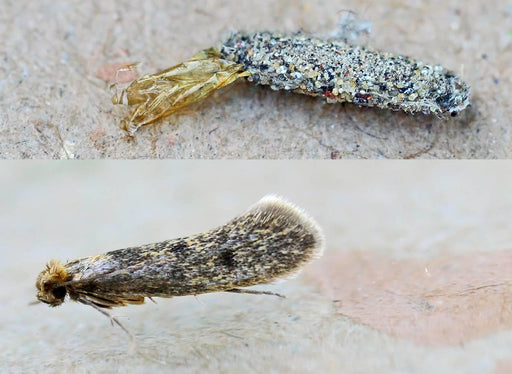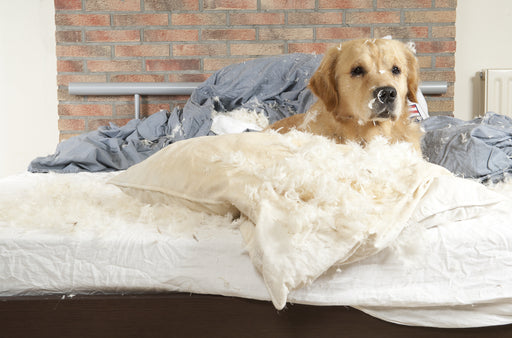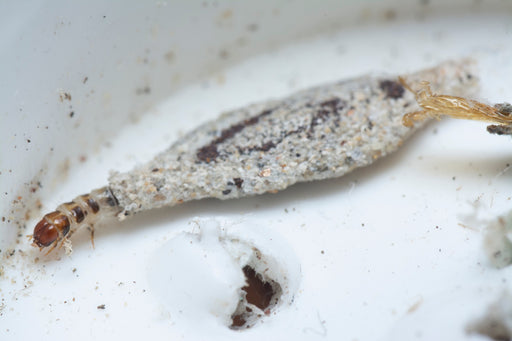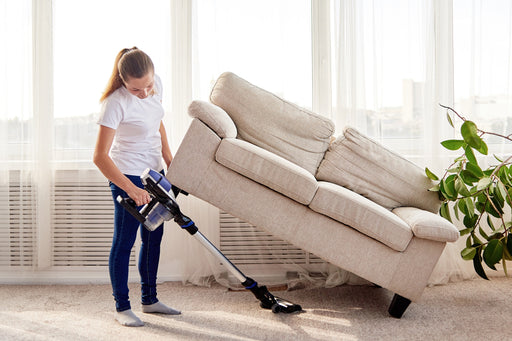The Case Bearing Moth - A Homeowners Guide
 By © entomart
By © entomart
We know only too well the damage that can be caused by Case Bearing Moths. You won’t believe the havoc they can cause! Obviously, it’s best to avoid an infestation entirely and know how to keep these little moths at bay. Although tiny, Case Bearing Moth larvae have a voracious appetite for carpet fibres and clothing made from natural fibres. Never fear! Here you’ll learn how to identify Case Bearing Moths and their larvae in this handy Homeowners Guide to Casemaking Moths - a seemingly perennial pest and source of worry for your carpets and clothes.
About Case Bearing Moths
The Casemaking or Case Bearing Moth (Tinea Pellionella) is found throughout North America. In the Outdoors, you will typically encounter adult Case Bearing Moths throughout summer and autumn (between June and October). Indoors, these moths are active throughout the year, and this is a serious problem for homeowners.
Case Bearing Moths can be found in bird nests, outbuildings, and inside your home. They tend to lay eggs on or near wool, feathers, hair, and fur. Because of their keratin-based diet they often end up in the carpet, but upholstery made of natural fibres and woollen fabrics are also on the menu for the Case Bearing Moth Larvae.
What separates the Case Bearing Moth from other Clothes Moths is the silken casing that the larvae leave behind while chewing through your carpet fibres. The larva lives inside the case at all times and feeds itself by poking its head out of the end.

Case Bearing Moth Characteristics
The adult Tinea Pellionella is small, with a wingspan around 9-16 mm long. The forewings are mottled with brown and black spots in different sizes. Both sets of wings have a fringe that distinguishes the Case Bearing Moths from other Clothes Moths. Their heads are rust-coloured.
Case Bearing Moth Larvae live in portable silken cases, which you might notice moving around. The larvae use whichever materials they find to make their casings, so the colours can vary and blend in with the carpet or clothing they are on. As the cases are mainly made of their silk they usually resemble grains of rice or small rolled up bits of toilet paper! The larvae themselves have a brown head and a dark brown upper segment.
Life Cycle of Case Bearing Carpet Moth
Case Bearing Carpet Moths live only to reproduce, and a female moth can lay several hundred eggs in her lifetime. Eggs hatch within 4-10 days, and the larvae will then feed for between 2-30 months before pupating. Moths will emerge from cocoons after 8-10 days and live for 30-45 days.
The reason for the varying time range is down to temperature and humidity differences affecting the efficiency of the moth life cycle.
For example, in southern US states, where it is slightly warmer and more humid, Casemaking Clothes Moths may produce two generations per year! Meanwhile, Case Bearing Moths (also known as Casemaking Moths) in the North can only produce a single generation. Therefore, if you live in the South, getting a Case Bearing Moth infestation under control is going to take more work than if you live in the North.

Case Bearing Moth Control Methods
If you discover a Case Bearing Moth on the walls of your home, expect there to be more! Look around the corners of and behind your drawers, cabinets, closets, and any undisturbed dark places in your home. Remember: the damage is done by the larvae and not by the adult Case Bearing Moths.
The best way to actively deal with a Case Bearing Moth issue is to regularly vacuum your carpets. This won’t be enough on it’s own, so you will need MothPrevention Clothes & Carpet Moth Traps, these are the perfect Moth Traps for Casemaking Moths - designed to attract the sexually active adult males. In addition, you’ll need a Moth Killer Kit to remove the moth eggs and larvae. You may need to set-up multiple traps to get your moth problem under control.
Time to Deal With Those Moths
Now that you know how to identify adult Case Bearing Moths and their larvae, You'll know if this particular moth is in your home. If you have Case Bearing Moths, you need to start thoroughly vacuuming, cleaning using a Moth Killer Kit and hanging moth traps immediately. Actively working to counteract the damages they create is the only way to get an infestation contained.
FAQ
How do you get rid of Case Bearing Moths?
The first step to getting rid of Case Bearing Moths is to thoroughly vacuum your carpets, closets and any areas where you suspect that moths are present. You will need to remove everything made of natural fibres from the infected area and inspect it closely. Clothes Moths tend to be attracted to stains, food remnants, and sweat on woollen items, so even if your clothes don’t have any evidence of moth damage, you should still wash or dry clean them. Next, hang some MothPrevention Clothes Moth Traps and use a killer kit to finish off the remaining moths.

What causes Case Bearing Moth infestation?
Case Bearing Moths can come into your home through an open window, on a bag of groceries, or even on clothing. Once inside, they will seek out a food source for their larvae and try to find a mate. Soon after, they will lay their eggs and the moth life cycle will begin.
Do Case Bearing Moths bite?
No, Case Bearing Moths do not bite, as they don’t have mouths. You don’t have to worry about larvae biting you either. The only thing Case Bearing Moth larvae bite is their food source, which is animal fibres, hair, and anything else that contains keratin.
About MothPrevention
MothPrevention® speak to customers every day about their clothes moth issues - clothes moths are a species that are ever increasing and that can cause significant damage to clothes, carpets and other home textiles.
To date, we’ve helped over 250,000 customers deal with their moth problems. We have developed professional grade solutions including proprietary pheromones and trap design engineered to the highest production standards.





